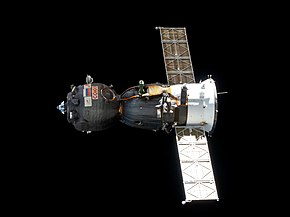
Back Soyuz (nau espacial) AN سايوز (عائلة مركبات فضائية) Arabic Soyuz AST Саюз (касмічны карабель) Byelorussian Союз (космически кораб) Bulgarian সয়ুজ (মহাকাশযান) Bengali/Bangla Soyouz (egorlestr) Breton Soiuz (nau espacial) Catalan سویوز CKB Sojuz (kosmická loď) Czech
 Soyuz MS, the latest version of the spacecraft | |
| Manufacturer | Energia |
|---|---|
| Country of origin | Soviet Union, Russia |
| Operator | Soviet space program (1967–1991) Roscosmos (1992–present) |
| Applications | Carry cosmonauts to orbit and back (originally for Soviet Moonshot and Salyut and Mir space station transportation) |
| Specifications | |
| Crew capacity | 3 |
| Regime | Low Earth orbit, Medium Earth orbit (circumlunar spaceflight during early program) |
| Design life | Up to 6 months (docked to International Space Station) |
| Production | |
| Status | In service |
| Maiden launch | Kosmos 133: 28 November 1966 (uncrewed) Soyuz 1: 23 April 1967 (crewed) |
| Last launch | Latest launch: Soyuz MS-25 23 March 2024 (crewed) |
| Related spacecraft | |
| Derivatives | Shenzhou, Progress |
Soyuz (Russian: Союз, IPA: [sɐˈjus], lit. 'Union') is a series of spacecraft which has been in service since the 1960s, having made more than 140 flights. It was designed for the Soviet space program by the Korolev Design Bureau (now Energia). The Soyuz succeeded the Voskhod spacecraft and was originally built as part of the Soviet crewed lunar programs. It is launched on a Soyuz rocket from the Baikonur Cosmodrome in Kazakhstan. Between the 2011 retirement of the Space Shuttle and the 2020 demo flight of SpaceX Crew Dragon, the Soyuz served as the only means to ferry crew to or from the International Space Station, for which it remains heavily used. Although China did launch crewed Shenzhou flights during this time, none of them docked with the ISS.
© MMXXIII Rich X Search. We shall prevail. All rights reserved. Rich X Search